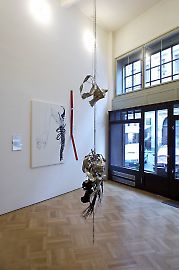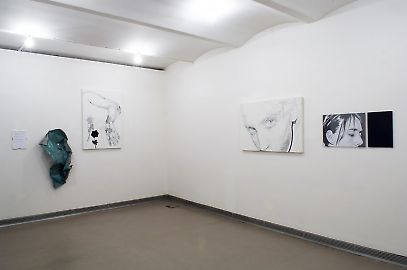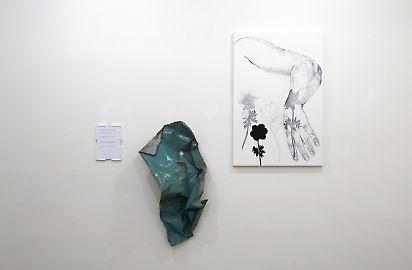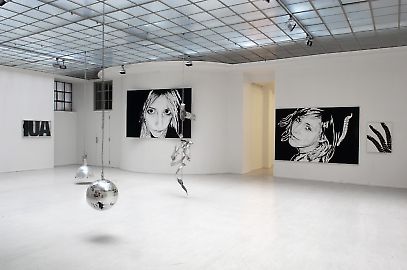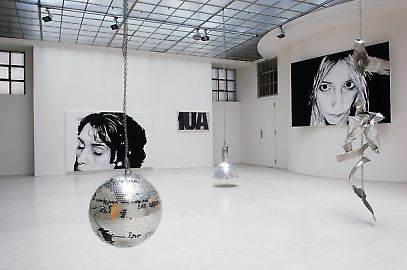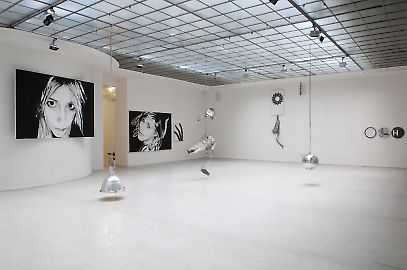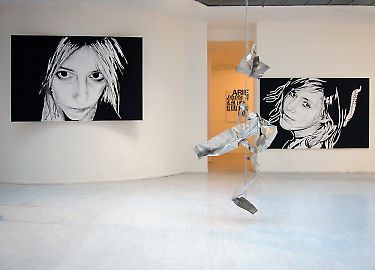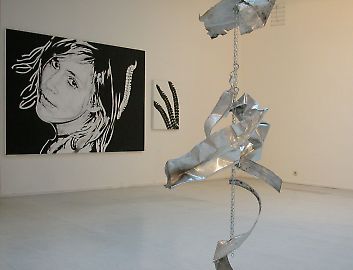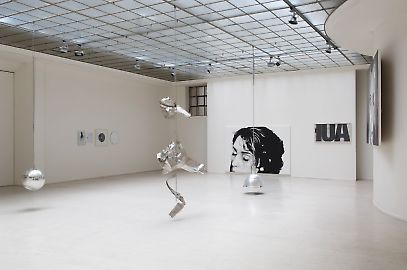Franz Graf -- ( ele"gi ;)
THE DRAWINGS THE OBJECTS THE WORDS
RESPOKEN DEFORMED FROM MEMORY
INCOMPLETE-BLACK>GRAY>WHITE
A GRAY ZONE LIKE THE PORTRAITS THE FACES NO LONGER HAVE NAMES
LIKE CAR DUMPTHROUGH
THE ASYNRCRONICITY OF TEXT AND IMAGE THE ELEMENTS
FROM THE PAST FOR VIEWING MEMORY
SAY HELLO AND WAVE GOODBYE.
F.G.
Images, drawings, installations, photographs, works with text and sound are the media in which Franz Graf moves and works. Shaped by his previously developed language of motifs, in Franz Graf’s fine-lined drawings of recent months there is often something ornamental, something geometrical, symbolic, emblematic combined with fragmentary words and quotations from film and literature. By leaving things out, replacing, or using translation machines, Franz Graf dissects and alienates prose and poetry, taking them to new levels of meaning. These transformed literary fragments trigger chains of association, just like the large format portraits whose anonymous female identities can be traced back to the “abbey nurse” from Trakl’s poem. Beside semantics and content, on the visual level Graf also plays with the aesthetic aspect. The assemblage of various fonts can be found next to floral elements that often run like nerve tracts out of the body.
The autumn night comes down into such method a cooling. If their white habit
sparkles like the asterisks, over the interrupted human bodies
is the Monasterykrankenschwester quietly.
They dark opening within I, you are strong, the form, which consist of
autumn cloud, and golden evening silence
At smoothing the wood of the autumn are of the tone of the weapons of death
fully, golden catches and blue seas, over those the
colluding sun of roll down
And of the Schilfen the tone of the dark flutes of the autumn rises.
O prouder wrong! They bronzieren old AR, the hot flame of the spirit
drawn in today by more tremendous pain, unborn
By interrupted Kieferbaeume the mountain stream darkness turns
A in the green light
georg trakl
( ele"gi ;) | Elegy
Definition: Mourning, lament, melancholy, farewell are traditional themes of the elegy, which can be traced back to Roman-Hellenistic authors such as Ovid, Propertius, and Tibullus. Enjoying a renewed heyday with the coming of humanism, it was also widespread
during romanticism.
The exhibition ( ele"gi ;): a biomorphic collage, samples and fragments emerge in a work-inprogress. Using the technique of collage, concepts and constructions are emptied und desired.
„we both, nehmlich the well-known Kleist and I find us here with
Stimmings on the way after post office dam, in a very clumsy, by being
situated shot there,
and now the quality of a well-meaning friend against long, in order to
transfer our frail covering, to the safe castle of the earth.
Seek dearest Pequilhen this evening here to arrive and everything in
such a way organize that my good bird is erschrekt as little as
possible thereby"
heinrich von kleist-henriette vogel
Crushed metal and car parts, like the twisted body parts, spines and hands in the drawings, stand for vulnerability, deformation, fugacity, and are brought into a new contexts of meaning. Processes of deconstruction and constructivism take place almost simultaneously. In so doing, Franz Graf reacts directly to his surroundings, placing them in relation to architectural space and combining them with political and sociological surroundings.
Because become now in the letzen NOT
having we ourselves the MIRACLE.
Karl Wolfskehl, 1910
From a conceptual position, Franz Graf works with abstraction as well as chains and intersections
of various media. Franz Graf has created archives in both his drawings and his photographic works. He uses a collection of collected documents that have been obtained from storage, selected and rearranged. Through the asynchronous opposition of text and image in a new context, the elements are used from the past to complete memories and evaluate the present. His spatial installations are marked by a fragmentary associative element that appeals to emotions and unconscious processes; a universe that cannot be grasped in a single glance opens up.
”I don’t know,” I called out soundlessly, “I don’t know. If nobody comes, then nobody
comes.”
kafka


